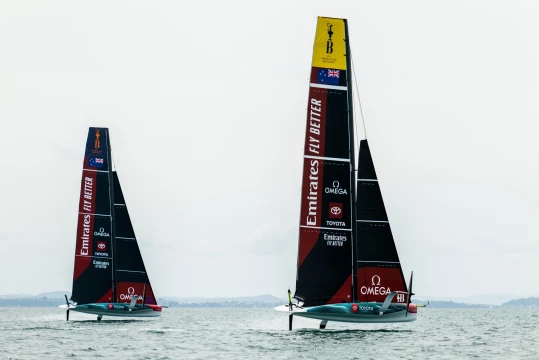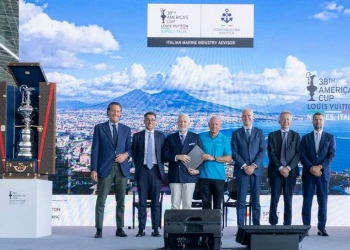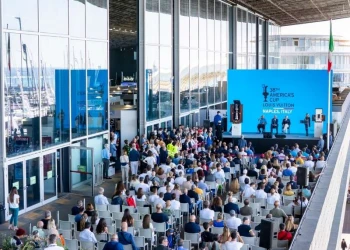
ph. Adam Mustill/America's Cup
Team New Zealand, the light air flyers
After the master-blasting, almost demonstration-sailing, that we saw earlier in the week from Emirates Team New Zealand, Friday’s session was one for the tweakers and wind whisperers but once again the sailing team showed the range of their abilities with some fascinating sail control on display.
The LEQ12, replete now with a giant yellow sticker on its ever-so slightly larger span (at the head) mainsail than AC40-3’s one design version, was inducing huge camber lower down and keeping the power all the way up with no inversions of the head today in order to stay on the foils as the wind faded and oscillated before settling in the 8-10 knot range. What was encouraging to see however, was that even in the super-light, the AC40 concept is a light-airs flyer and once up on the foils, the maintenance of power looked relatively easy.
With so much concentration on sail design, it was a coup for the Recon Unit to grab the legendary Burns Fallow, a stalwart of the North Sails Auckland loft and Global Superyacht Manager who is ETNZ’s Chief Sail Designer, for an interview with a key team member widely regarded in the America’s Cup as the finest sailmaker. Looking at the LEQ12 development he set the scene saying: “These boats have massive ranges of power requirement from 8 knots of apparent wind speed to 60 knots so trying to get something with a lot of controls there and just how we do that is, well…top secret.” When asked about the mainsail inversion we’ve seen, Fallow offered: “Well, going back to the big boats, the 72s, that was definitely the game but of course they are much taller rigs so that was a necessity but when your apparent wind is getting right up there even on these short little stubby rigs, that also comes into play.”

Looking at the new rules instigated by the Defender and Challenger of Record, Fallow gave a lot of detail saying: “There's only so many we can do in the rules, the rules were drafted to be quite restrictive both in what we can do in LEQ world or on legacy boats…so yeah they are pretty restrictive so I'd imagine most teams will end up using most of their available (sail) slots even right through to when we get back into AC75 new boats next year…When we re-drafted the rule, the first thing we did was create a rule which limits how much kink you can have in each batten so we can’t do a bat wing again, thank goodness, but one thing we did do was actually widen the area range, it used to be 135 to 145 and it’s now 130 to 145 so there is a bigger area range to explore…but we can only build six new mainsails so you are going to have to think pretty hard about how you use those six slots.”y
Clearly though, the development work that has gone into the ETNZ LEQ12 in terms of sails and foils so far – as well as some neater rig and systems controls unseen below deck – was having a big effect on speed. When flying on the port anhedral on starboard tack, the LEQ12 is, according to the recon team: “quicker but more twitchy than the AC40, whilst on port tack, there is not much in it.”
And that’s been a theme all the way through the wind ranges. Pete Burling and Nathan Outteridge are very much into the windward heel, bow down technique that they showed again today in the light airs to devastating effect but in the racing today, it was the AC40 with Olympic Finn representative Josh Junior on the wheel in the starboard pod, that was creating merry hell in the pre-starts, shutting out Pete Burling on one memorable run into the line. The AC40-3, set in auto-pilot mode, offers a fantastic platform for one-design racing and from what we are seeing in Auckland, we can only imagine what six boats lined up on a fleet-racing start line in Barcelona will be like. Electric.

Emirates Team New Zealand will be shoreside for a while now as a cyclone weather system develops over the north island and the team aren’t expected out until midweek at the earliest. Plenty to digest though from a light airs session to finish the week in Auckland that also saw AC40-3 christened in what has become a treasured tradition, with iwi manaaki Ngāti Whātua Ōrākei naming and blessing the team’s latest boat ‘Te Kākahi’, the Māori word for Orca.





